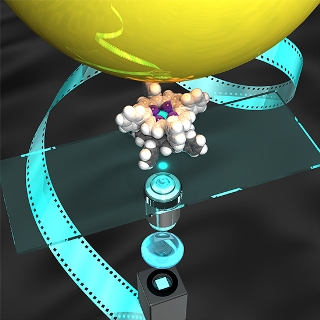Aug 22 2014
A research group led by Professor Hiroyuki Noji, Department of Applied Chemistry, Graduate School of Engineering, University of Tokyo, successfully observed and touched the rotational motion of a 1-nm synthetic molecular machine through the application of a single-molecule capturing and manipulation technique using optical microscopy and a bead probe (single-molecule motion capturing), which allows visualization of molecular mechanical motion.
 Figure from the press release material. Schematic diagram illustrating single-molecule motion capturing and manipulation of 1-nm synthetic molecular machine by optical microscopy using a bead probe (single-molecule motion capturing).
Figure from the press release material. Schematic diagram illustrating single-molecule motion capturing and manipulation of 1-nm synthetic molecular machine by optical microscopy using a bead probe (single-molecule motion capturing).
1 Molecule motion capturing is a technique originally invented for studying the functions of energy-conversion molecules in vivo (biomolecular machines). It had been hoped that this technique would be available for the measurement of artificial molecular machines (synthetic molecular machines) because of its broad applicability such as “seeing and touching” a single biomolecular machine as well as measuring the direction of its movement. However, it had been difficult to apply this technique to synthetic molecular machines because they are about 1 nm in size, which is one-tenth the size of biomolecular machines, which are about 10 nm in size.
Recently, Professor Noji’s group has further improved the single-molecule motion capturing technique, using a bead of 200 nm in diameter which is visible by optical microscopy. With this technique, the rotational motion of a double-decker porphyrin (DD) of 1 nm in size was observed. The conventional method was improved by dealing with issues such as the low efficiency of the immobilization reaction due to the small size of synthetic molecular machines and undesirable interaction between the bead and the substrate. These improvements broadened its applicability. Furthermore, the group successfully manipulated the motion of the DD molecule by applying an external force to the bead. Since the smallest bio- and synthetic molecular machines are 1 nm in size, this method will enable visualizing the movements of any molecular machine. This is currently the only method available to evaluate the performance of a single synthetic molecular machine through “seeing and touching” it, and to verify whether synthetic molecular motors are generating their own locomotive power, which is one of the goals being pursued with synthetic molecular machines. Suppose that, for example, a light-driven synthetic molecular motor is created in the future, and that it can be connected to a biomolecular motor, then it may be feasible to develop custom-made energy conversion technology that can manipulate various light-related chemical reactions.
This research was jointly carried out with project researcher Tomohiro Ikeda and Takahiro Tsukahara, Department of Applied Chemistry, Graduate School of Engineering, University of Tokyo, Professor Ryota Iino, Molecular Machine Designing Laboratory, Okazaki Institute for Integrative Bioscience, National Institute of Natural Sciences, and Masayuki Takeuchi, group leader, Organic Materials Group, Polymer Materials Unit, National Institute for Materials Science. This study was funded by the CREST program offered by Strategic Basic Research Programs, Japan Science and Technology Agency.
The results of this research will be soon published in the scientific journal, Angewandte Chemie International Edition (in English), issued by the German Chemical Society. Since this paper was regarded as significant by the society, it was selected as a “hot paper” and will be highlighted on the front and back covers of the issue.